Davey’s Locker Whale Watching offers multiple daily departures year round departing from Newport Harbor in Newport Beach. With many different types of whales and several varieties of dolphin, Newport Beach has become one of the top whale watching destinations in the world. Below are whale and dolphin species commonly viewed by month:

JANUARY
The height of the southbound leg of the Gray whale migration. The Grey Whales are heading south towards Baja to their winter breeding grounds. During January up to five or more Gray whales can be viewed during single cruise. Finback whales are also regularly viewed in January. Finback whales are the second largest of all whales. Humpback whale sightings are also possible as well as killer whales. Common Dolphin, Pacific White Side Dolphin, Bottlenose Dolphin, and Risso Dolphin are all commonly viewed in January.
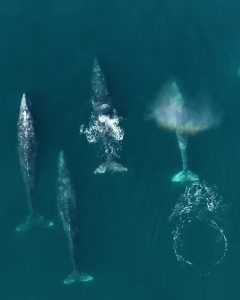
FEBRUARY
Gray whales continue their migration south for the first part of the month. This is one of the peak migration months for Grey Whales, and multiple Gray Whales sighted during single whale watching cruise is common. Towards the end of February you might see a few Gray Whales moving north back to Alaska. Typically, the early northbound whales are males. Finback Whales, Humpback Whales, and even Orca (Killer Whales) may also be sighted during this month. Pacific White Sided Dolphin, Inshore Bottlenose Dolphin and Common Dolphin are regularly encountered during February as well.
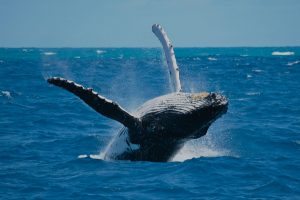
MARCH
The other peak month for the annual Gray Whale migration. During this month, it is common to get southbound Gray Whales heading to Baja and northbound Gray Whales heading to Alaska as well. Multiple Gray Whales per cruise is common during March. This is also considered the best month for viewing Humpback Whales. Killer Whales and Finback Whales are also possible. Inshore common dolphin, bottlenose dolphin, and Risso dolphin are also viewed. March is usually the last month that we see The Pacific White Side Dolphin.
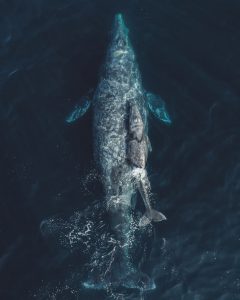
APRIL
By April nearly all of our Grey Whale sightings are moving northbound. This is the time where female Gray Whales are traveling with calves, born while in Baja. Gray Whale mothers and their calves make for some amazing viewing. Gray Whale calves often provide very extending viewing opportunities while just outside the surf line. Although a bit early giant Blue Whales have made their first appearances in April with some incredible viewing opportunities. Blue Whales are the largest of any animal on the planet. Finback Whales, Humpback Whale, and Minke Whales are also in the area allowing the opportunity to view all of our common whales in the same month, possibly, though extremely rare, on the same trip.
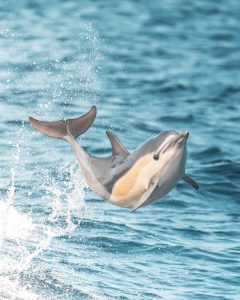
MAY
Gray Whale mothers and calves continue heading north during the first half of the month. Blue Whale viewings become more frequent and multiple viewings of the largest of all whales are possible. Finback Whales, Minke Whales, Humpback Whales, and even Orca (Killer Whales) make this the other best month for large variety of the type of whales viewed. Mega pods of Common Dolphin may also be viewed. Hundreds or even thousands of dolphin can make up just one pod and offers an amazing viewing experience.
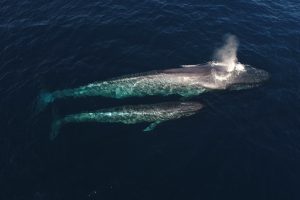
JUNE
The official start of summer. Giant Blue Whales, Finback Whales, and Minke Whales are in full swing feeding on krill. Lunge feeding may be observed. During these feeding periods, the whales become very oblivious to everything but food making for some amazing viewings. Mega pods of dolphin become common. With some of the longest days of the year you can choose from the many cruise times including even a sunset cruise option.

JULY
Some of the warmest water temperatures of the year makes this the best month for the mega pods of dolphin unique to southern California. Blue Whales are regularly found and it is common to see several whales in same area feeding on krill. Although the Blue Whale is the most commonly viewed in July we also see Finback Whales and Minke Whales are also viewed.

AUGUST
Considered the peak month for the giant Blue Whales and Finback Whales. Viewings can be so good that trying to track a single blue whale becomes difficult as other Blue Whales move about. Lunge feeding and fluking whales makes for great viewings. Dolphin can be observed bubble netting baitfish. Giant sunfish are very frequent. Marlin, Mako sharks, Thresher sharks, and all kinds of sea life leave little down time during a cruise.
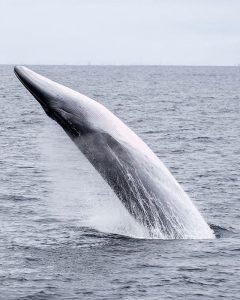
SEPTEMBER
Kids go back to school but the whales continue. Great month for the giant Blue Whales, Finback Whales, and Minke Whales. Several species of dolphin are available. Mega pods of Common Dolphin are often encountered. Best weather month with lake like, glassy conditions all day long. This is considered one of the favorite months for local whale watching enthusiast.
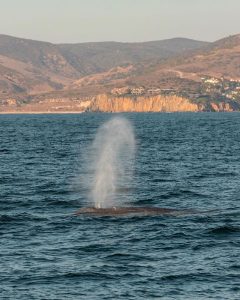
OCTOBER
Days are getting shorter. Blue Whales continue and multiple sightings are common. Finback Whales are also quite numerous. Another great weather month. Risso dolphin the largest of all dolphin make for some exciting viewing opportunities.
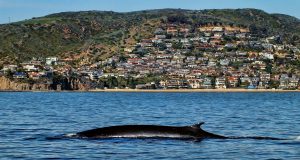
NOVEMBER
Fall has arrived. For the first part of the month, Blue Whales and Finback Whales can be quite numerous. Towards the end of November, the Blue Whales and Finback Whales begin to head south. Minke whales may still be present during this month as well. Although a little early, later in the month may be the first viewings of Gray Whales as they head south on their annual migration. November is also the month that Pacific White Side Dolphin return to the area.

DECEMBER
The official start of the Gray Whale migration this month often has single male Gray Whales heading south to Baja. Humpback Whales and Orca (Killer Whales) can make for some exciting viewings during December. Common and inshore bottlenose dolphin are very frequent. Sea lions at their year round colony welcome cruises back to Newport Bay. December is perfect month for those worried about motion sickness, as this is very mild month. Finback Whales are also viewed during this month but with less frequency than the previous months. Blue Whales have usually moved out.
